COIT 20252: Business Process Management in Construction - Case Study
VerifiedAdded on 2023/03/31
|28
|6402
|80
Case Study
AI Summary
This case study report analyzes the Business Process Management (BPM) journey of 'Company A', a construction firm, focusing on the need for business process improvement, organizational maturity, process modeling, and continuous improvement. It highlights the necessity of BPMN, advantages of BPM, and similarities between BPM and BPR. The report also explores Capability Maturity Models (CMM) and Lean Philosophy, differentiating between 'as-is' and 'to-be' processes, analyzing process outcomes, and identifying problem areas. Furthermore, it addresses challenges in process modeling and improvement, lessons learned, and critical success factors for effective BPM implementation within the construction industry. This document is available on Desklib, a platform offering study tools and resources for students.
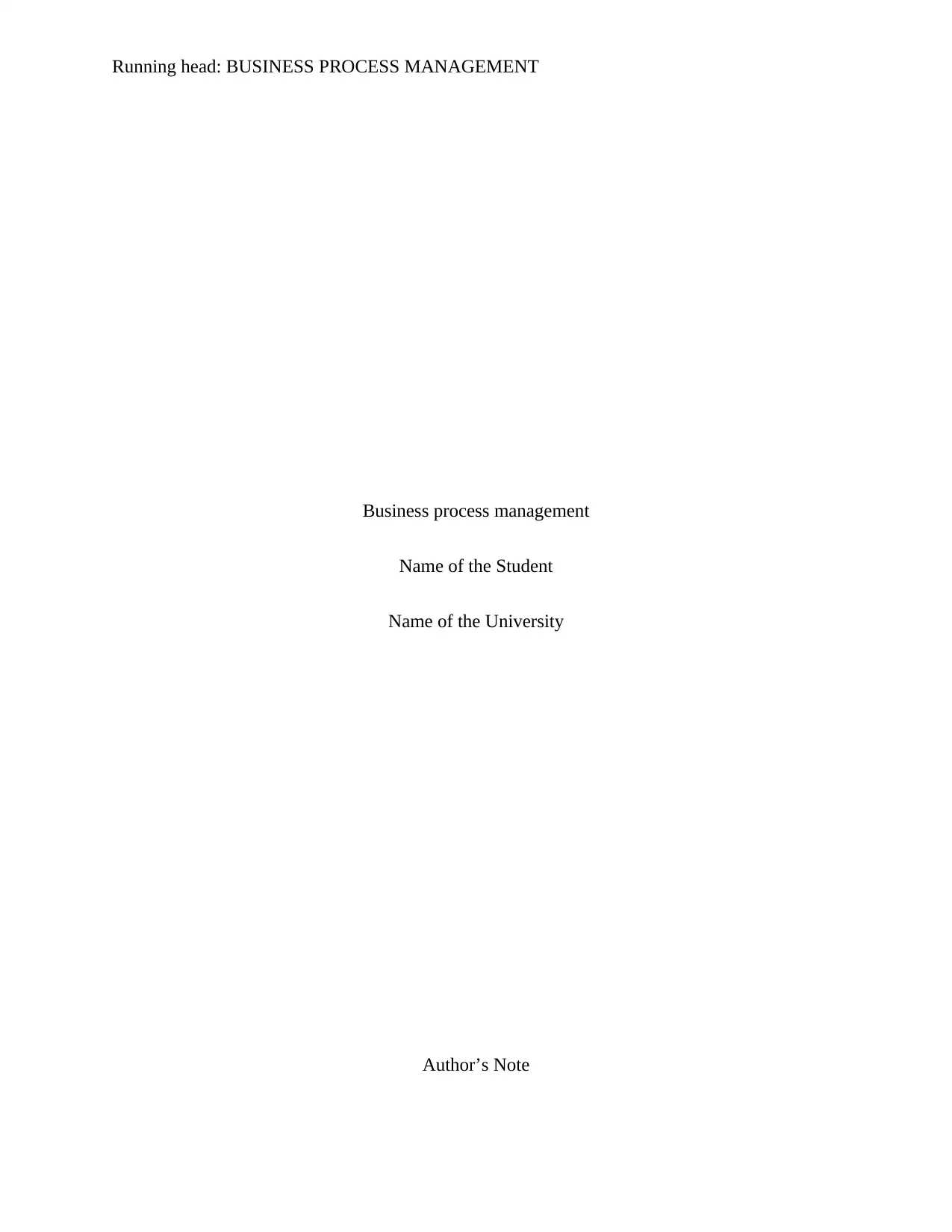
Running head: BUSINESS PROCESS MANAGEMENT
Business process management
Name of the Student
Name of the University
Author’s Note
Business process management
Name of the Student
Name of the University
Author’s Note
Paraphrase This Document
Need a fresh take? Get an instant paraphrase of this document with our AI Paraphraser
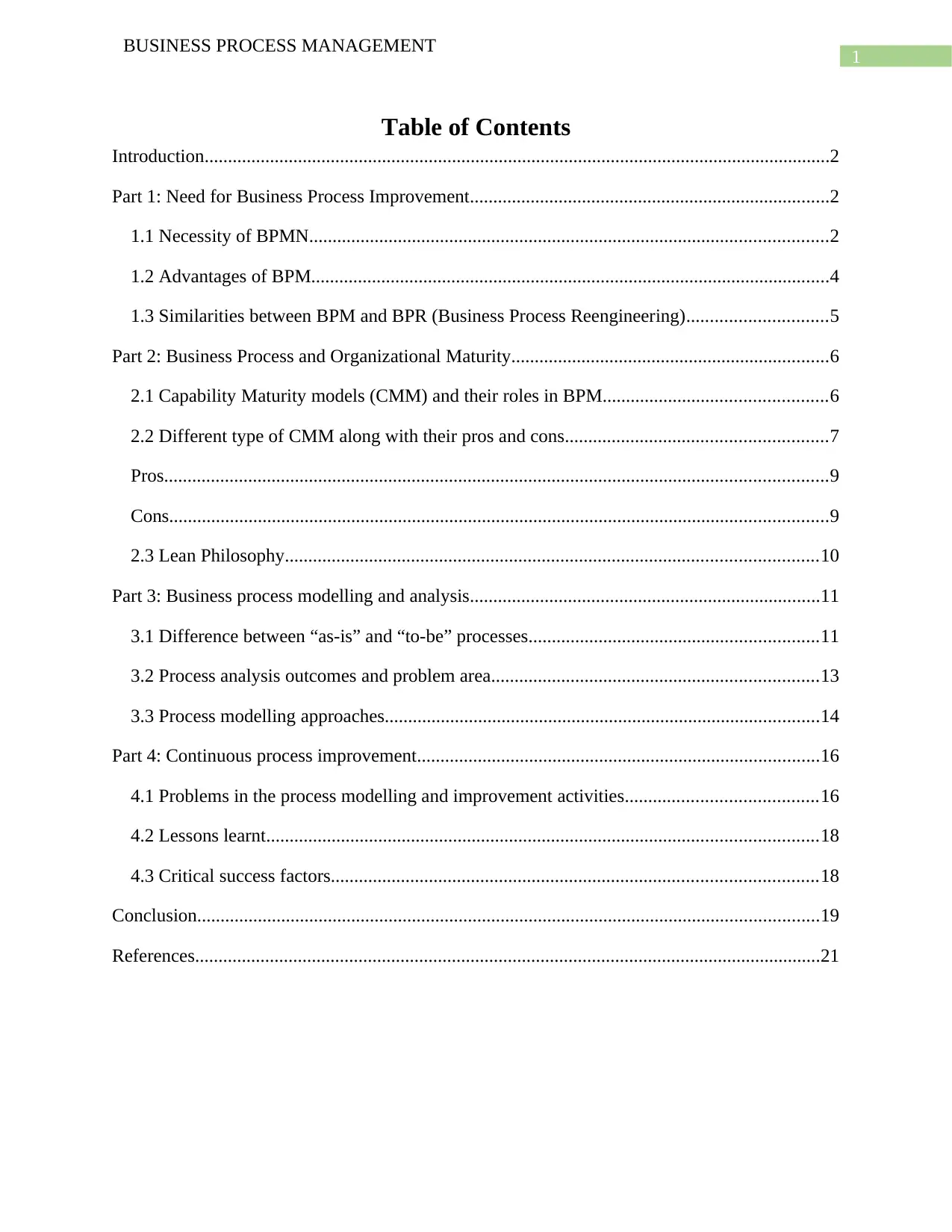
1
BUSINESS PROCESS MANAGEMENT
Table of Contents
Introduction......................................................................................................................................2
Part 1: Need for Business Process Improvement.............................................................................2
1.1 Necessity of BPMN...............................................................................................................2
1.2 Advantages of BPM...............................................................................................................4
1.3 Similarities between BPM and BPR (Business Process Reengineering)..............................5
Part 2: Business Process and Organizational Maturity....................................................................6
2.1 Capability Maturity models (CMM) and their roles in BPM................................................6
2.2 Different type of CMM along with their pros and cons........................................................7
Pros..............................................................................................................................................9
Cons.............................................................................................................................................9
2.3 Lean Philosophy..................................................................................................................10
Part 3: Business process modelling and analysis...........................................................................11
3.1 Difference between “as-is” and “to-be” processes..............................................................11
3.2 Process analysis outcomes and problem area......................................................................13
3.3 Process modelling approaches.............................................................................................14
Part 4: Continuous process improvement......................................................................................16
4.1 Problems in the process modelling and improvement activities.........................................16
4.2 Lessons learnt......................................................................................................................18
4.3 Critical success factors........................................................................................................18
Conclusion.....................................................................................................................................19
References......................................................................................................................................21
BUSINESS PROCESS MANAGEMENT
Table of Contents
Introduction......................................................................................................................................2
Part 1: Need for Business Process Improvement.............................................................................2
1.1 Necessity of BPMN...............................................................................................................2
1.2 Advantages of BPM...............................................................................................................4
1.3 Similarities between BPM and BPR (Business Process Reengineering)..............................5
Part 2: Business Process and Organizational Maturity....................................................................6
2.1 Capability Maturity models (CMM) and their roles in BPM................................................6
2.2 Different type of CMM along with their pros and cons........................................................7
Pros..............................................................................................................................................9
Cons.............................................................................................................................................9
2.3 Lean Philosophy..................................................................................................................10
Part 3: Business process modelling and analysis...........................................................................11
3.1 Difference between “as-is” and “to-be” processes..............................................................11
3.2 Process analysis outcomes and problem area......................................................................13
3.3 Process modelling approaches.............................................................................................14
Part 4: Continuous process improvement......................................................................................16
4.1 Problems in the process modelling and improvement activities.........................................16
4.2 Lessons learnt......................................................................................................................18
4.3 Critical success factors........................................................................................................18
Conclusion.....................................................................................................................................19
References......................................................................................................................................21
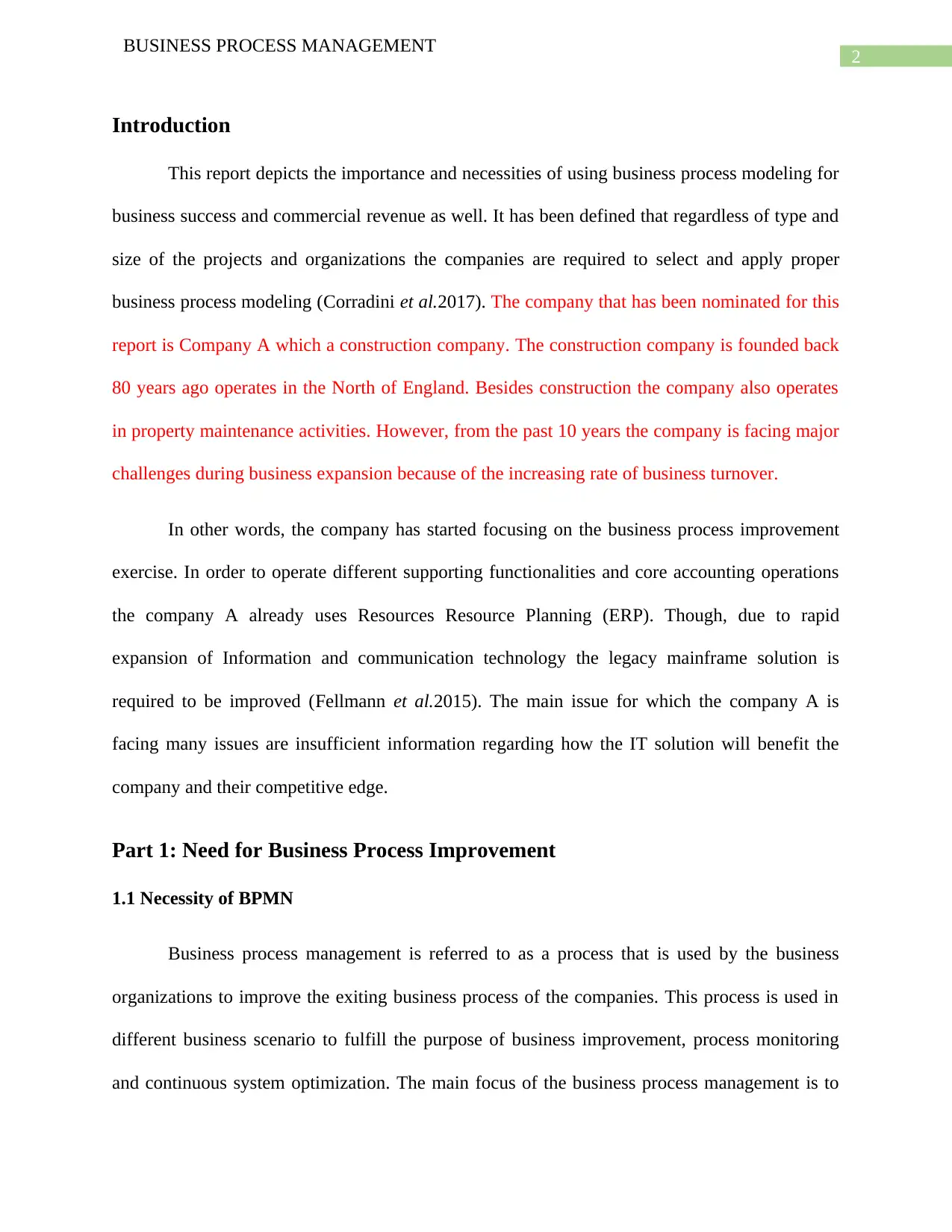
2
BUSINESS PROCESS MANAGEMENT
Introduction
This report depicts the importance and necessities of using business process modeling for
business success and commercial revenue as well. It has been defined that regardless of type and
size of the projects and organizations the companies are required to select and apply proper
business process modeling (Corradini et al.2017). The company that has been nominated for this
report is Company A which a construction company. The construction company is founded back
80 years ago operates in the North of England. Besides construction the company also operates
in property maintenance activities. However, from the past 10 years the company is facing major
challenges during business expansion because of the increasing rate of business turnover.
In other words, the company has started focusing on the business process improvement
exercise. In order to operate different supporting functionalities and core accounting operations
the company A already uses Resources Resource Planning (ERP). Though, due to rapid
expansion of Information and communication technology the legacy mainframe solution is
required to be improved (Fellmann et al.2015). The main issue for which the company A is
facing many issues are insufficient information regarding how the IT solution will benefit the
company and their competitive edge.
Part 1: Need for Business Process Improvement
1.1 Necessity of BPMN
Business process management is referred to as a process that is used by the business
organizations to improve the exiting business process of the companies. This process is used in
different business scenario to fulfill the purpose of business improvement, process monitoring
and continuous system optimization. The main focus of the business process management is to
BUSINESS PROCESS MANAGEMENT
Introduction
This report depicts the importance and necessities of using business process modeling for
business success and commercial revenue as well. It has been defined that regardless of type and
size of the projects and organizations the companies are required to select and apply proper
business process modeling (Corradini et al.2017). The company that has been nominated for this
report is Company A which a construction company. The construction company is founded back
80 years ago operates in the North of England. Besides construction the company also operates
in property maintenance activities. However, from the past 10 years the company is facing major
challenges during business expansion because of the increasing rate of business turnover.
In other words, the company has started focusing on the business process improvement
exercise. In order to operate different supporting functionalities and core accounting operations
the company A already uses Resources Resource Planning (ERP). Though, due to rapid
expansion of Information and communication technology the legacy mainframe solution is
required to be improved (Fellmann et al.2015). The main issue for which the company A is
facing many issues are insufficient information regarding how the IT solution will benefit the
company and their competitive edge.
Part 1: Need for Business Process Improvement
1.1 Necessity of BPMN
Business process management is referred to as a process that is used by the business
organizations to improve the exiting business process of the companies. This process is used in
different business scenario to fulfill the purpose of business improvement, process monitoring
and continuous system optimization. The main focus of the business process management is to
⊘ This is a preview!⊘
Do you want full access?
Subscribe today to unlock all pages.

Trusted by 1+ million students worldwide
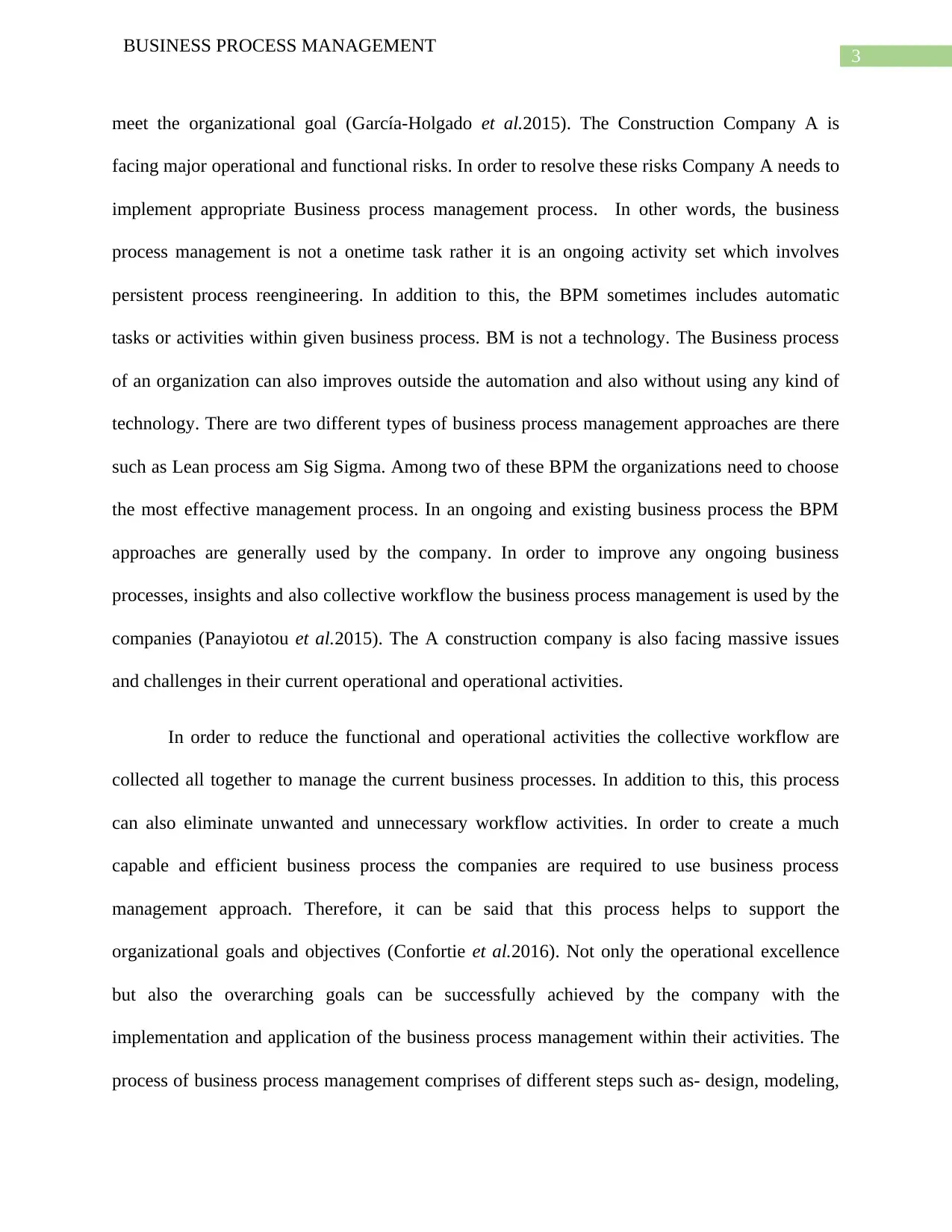
3
BUSINESS PROCESS MANAGEMENT
meet the organizational goal (García-Holgado et al.2015). The Construction Company A is
facing major operational and functional risks. In order to resolve these risks Company A needs to
implement appropriate Business process management process. In other words, the business
process management is not a onetime task rather it is an ongoing activity set which involves
persistent process reengineering. In addition to this, the BPM sometimes includes automatic
tasks or activities within given business process. BM is not a technology. The Business process
of an organization can also improves outside the automation and also without using any kind of
technology. There are two different types of business process management approaches are there
such as Lean process am Sig Sigma. Among two of these BPM the organizations need to choose
the most effective management process. In an ongoing and existing business process the BPM
approaches are generally used by the company. In order to improve any ongoing business
processes, insights and also collective workflow the business process management is used by the
companies (Panayiotou et al.2015). The A construction company is also facing massive issues
and challenges in their current operational and operational activities.
In order to reduce the functional and operational activities the collective workflow are
collected all together to manage the current business processes. In addition to this, this process
can also eliminate unwanted and unnecessary workflow activities. In order to create a much
capable and efficient business process the companies are required to use business process
management approach. Therefore, it can be said that this process helps to support the
organizational goals and objectives (Confortie et al.2016). Not only the operational excellence
but also the overarching goals can be successfully achieved by the company with the
implementation and application of the business process management within their activities. The
process of business process management comprises of different steps such as- design, modeling,
BUSINESS PROCESS MANAGEMENT
meet the organizational goal (García-Holgado et al.2015). The Construction Company A is
facing major operational and functional risks. In order to resolve these risks Company A needs to
implement appropriate Business process management process. In other words, the business
process management is not a onetime task rather it is an ongoing activity set which involves
persistent process reengineering. In addition to this, the BPM sometimes includes automatic
tasks or activities within given business process. BM is not a technology. The Business process
of an organization can also improves outside the automation and also without using any kind of
technology. There are two different types of business process management approaches are there
such as Lean process am Sig Sigma. Among two of these BPM the organizations need to choose
the most effective management process. In an ongoing and existing business process the BPM
approaches are generally used by the company. In order to improve any ongoing business
processes, insights and also collective workflow the business process management is used by the
companies (Panayiotou et al.2015). The A construction company is also facing massive issues
and challenges in their current operational and operational activities.
In order to reduce the functional and operational activities the collective workflow are
collected all together to manage the current business processes. In addition to this, this process
can also eliminate unwanted and unnecessary workflow activities. In order to create a much
capable and efficient business process the companies are required to use business process
management approach. Therefore, it can be said that this process helps to support the
organizational goals and objectives (Confortie et al.2016). Not only the operational excellence
but also the overarching goals can be successfully achieved by the company with the
implementation and application of the business process management within their activities. The
process of business process management comprises of different steps such as- design, modeling,
Paraphrase This Document
Need a fresh take? Get an instant paraphrase of this document with our AI Paraphraser
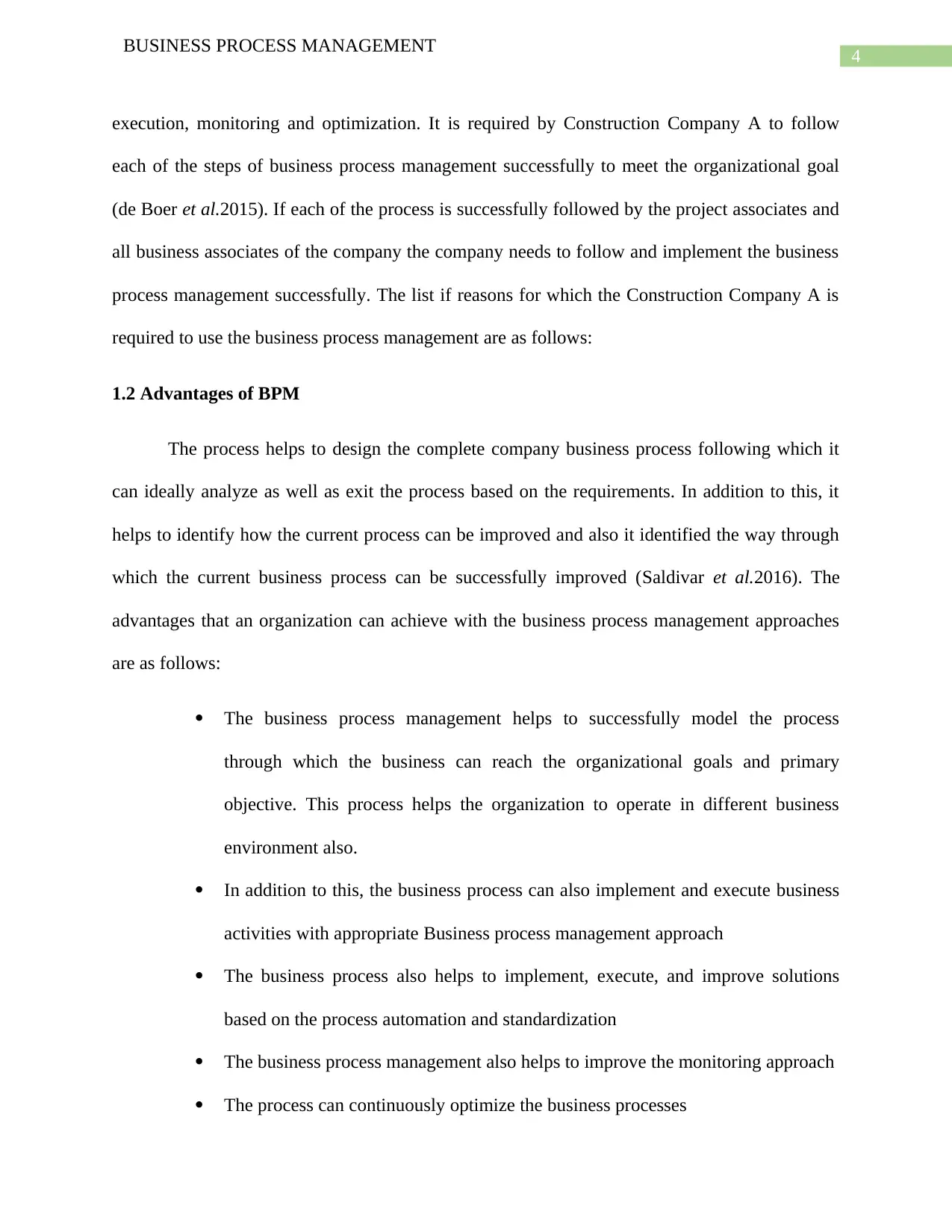
4
BUSINESS PROCESS MANAGEMENT
execution, monitoring and optimization. It is required by Construction Company A to follow
each of the steps of business process management successfully to meet the organizational goal
(de Boer et al.2015). If each of the process is successfully followed by the project associates and
all business associates of the company the company needs to follow and implement the business
process management successfully. The list if reasons for which the Construction Company A is
required to use the business process management are as follows:
1.2 Advantages of BPM
The process helps to design the complete company business process following which it
can ideally analyze as well as exit the process based on the requirements. In addition to this, it
helps to identify how the current process can be improved and also it identified the way through
which the current business process can be successfully improved (Saldivar et al.2016). The
advantages that an organization can achieve with the business process management approaches
are as follows:
The business process management helps to successfully model the process
through which the business can reach the organizational goals and primary
objective. This process helps the organization to operate in different business
environment also.
In addition to this, the business process can also implement and execute business
activities with appropriate Business process management approach
The business process also helps to implement, execute, and improve solutions
based on the process automation and standardization
The business process management also helps to improve the monitoring approach
The process can continuously optimize the business processes
BUSINESS PROCESS MANAGEMENT
execution, monitoring and optimization. It is required by Construction Company A to follow
each of the steps of business process management successfully to meet the organizational goal
(de Boer et al.2015). If each of the process is successfully followed by the project associates and
all business associates of the company the company needs to follow and implement the business
process management successfully. The list if reasons for which the Construction Company A is
required to use the business process management are as follows:
1.2 Advantages of BPM
The process helps to design the complete company business process following which it
can ideally analyze as well as exit the process based on the requirements. In addition to this, it
helps to identify how the current process can be improved and also it identified the way through
which the current business process can be successfully improved (Saldivar et al.2016). The
advantages that an organization can achieve with the business process management approaches
are as follows:
The business process management helps to successfully model the process
through which the business can reach the organizational goals and primary
objective. This process helps the organization to operate in different business
environment also.
In addition to this, the business process can also implement and execute business
activities with appropriate Business process management approach
The business process also helps to implement, execute, and improve solutions
based on the process automation and standardization
The business process management also helps to improve the monitoring approach
The process can continuously optimize the business processes
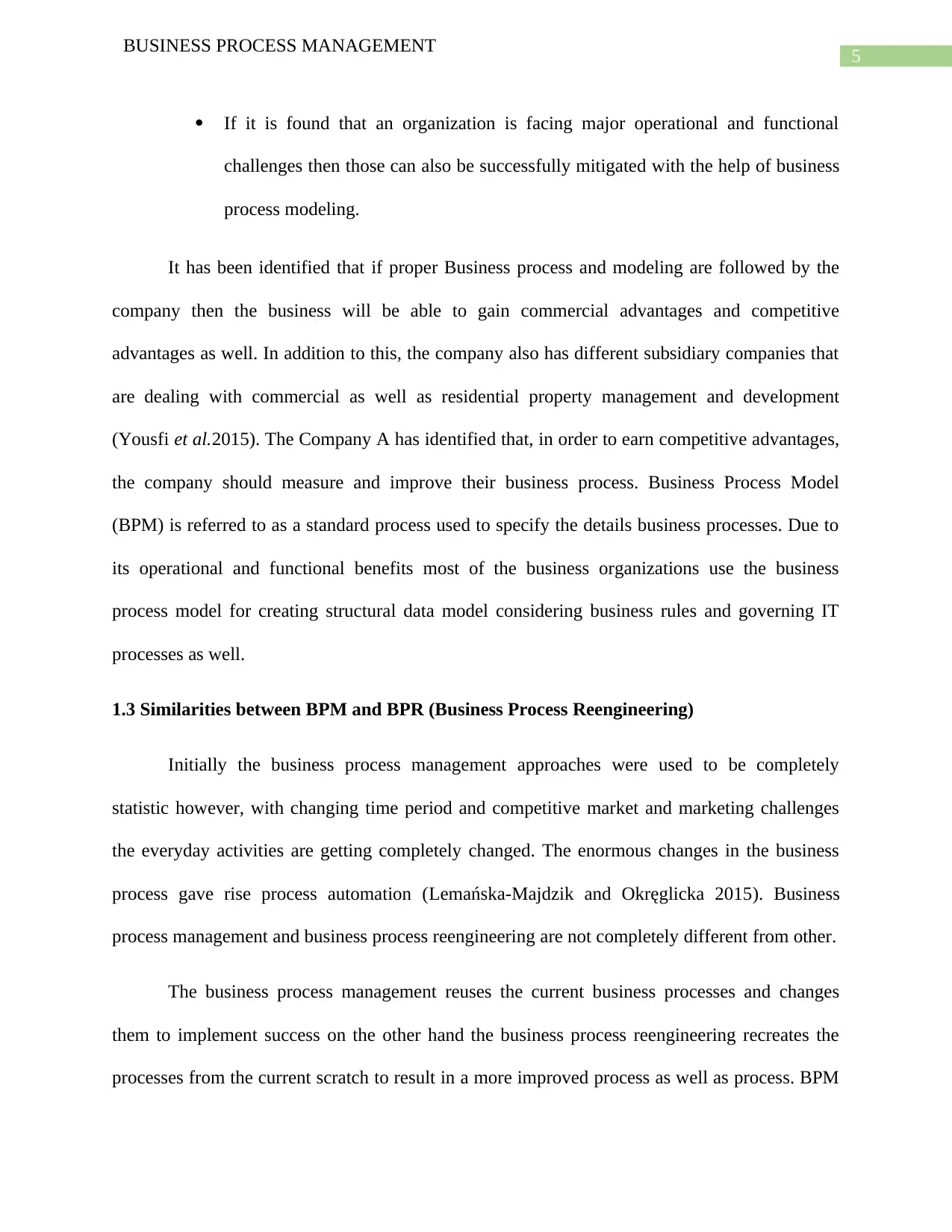
5
BUSINESS PROCESS MANAGEMENT
If it is found that an organization is facing major operational and functional
challenges then those can also be successfully mitigated with the help of business
process modeling.
It has been identified that if proper Business process and modeling are followed by the
company then the business will be able to gain commercial advantages and competitive
advantages as well. In addition to this, the company also has different subsidiary companies that
are dealing with commercial as well as residential property management and development
(Yousfi et al.2015). The Company A has identified that, in order to earn competitive advantages,
the company should measure and improve their business process. Business Process Model
(BPM) is referred to as a standard process used to specify the details business processes. Due to
its operational and functional benefits most of the business organizations use the business
process model for creating structural data model considering business rules and governing IT
processes as well.
1.3 Similarities between BPM and BPR (Business Process Reengineering)
Initially the business process management approaches were used to be completely
statistic however, with changing time period and competitive market and marketing challenges
the everyday activities are getting completely changed. The enormous changes in the business
process gave rise process automation (Lemańska-Majdzik and Okręglicka 2015). Business
process management and business process reengineering are not completely different from other.
The business process management reuses the current business processes and changes
them to implement success on the other hand the business process reengineering recreates the
processes from the current scratch to result in a more improved process as well as process. BPM
BUSINESS PROCESS MANAGEMENT
If it is found that an organization is facing major operational and functional
challenges then those can also be successfully mitigated with the help of business
process modeling.
It has been identified that if proper Business process and modeling are followed by the
company then the business will be able to gain commercial advantages and competitive
advantages as well. In addition to this, the company also has different subsidiary companies that
are dealing with commercial as well as residential property management and development
(Yousfi et al.2015). The Company A has identified that, in order to earn competitive advantages,
the company should measure and improve their business process. Business Process Model
(BPM) is referred to as a standard process used to specify the details business processes. Due to
its operational and functional benefits most of the business organizations use the business
process model for creating structural data model considering business rules and governing IT
processes as well.
1.3 Similarities between BPM and BPR (Business Process Reengineering)
Initially the business process management approaches were used to be completely
statistic however, with changing time period and competitive market and marketing challenges
the everyday activities are getting completely changed. The enormous changes in the business
process gave rise process automation (Lemańska-Majdzik and Okręglicka 2015). Business
process management and business process reengineering are not completely different from other.
The business process management reuses the current business processes and changes
them to implement success on the other hand the business process reengineering recreates the
processes from the current scratch to result in a more improved process as well as process. BPM
⊘ This is a preview!⊘
Do you want full access?
Subscribe today to unlock all pages.

Trusted by 1+ million students worldwide
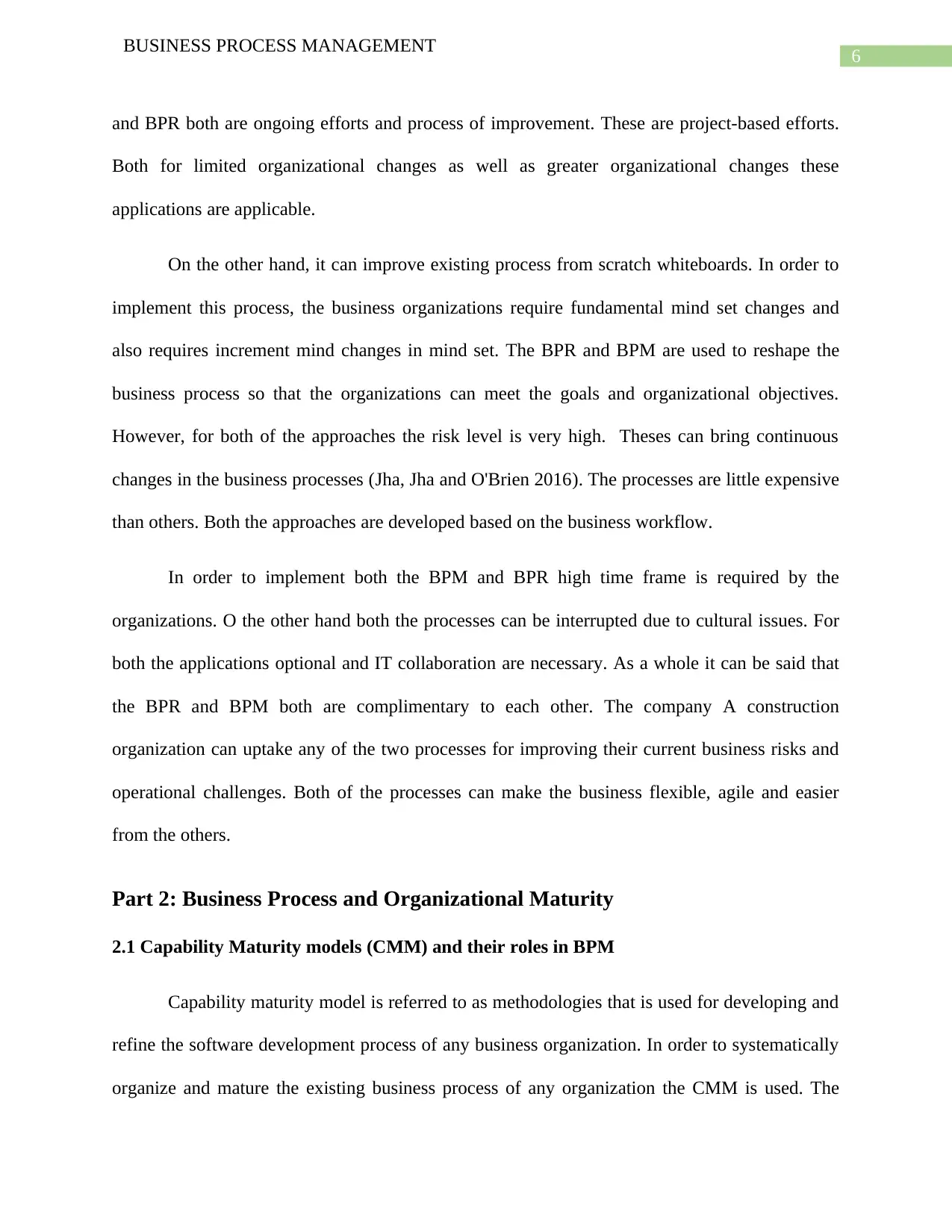
6
BUSINESS PROCESS MANAGEMENT
and BPR both are ongoing efforts and process of improvement. These are project-based efforts.
Both for limited organizational changes as well as greater organizational changes these
applications are applicable.
On the other hand, it can improve existing process from scratch whiteboards. In order to
implement this process, the business organizations require fundamental mind set changes and
also requires increment mind changes in mind set. The BPR and BPM are used to reshape the
business process so that the organizations can meet the goals and organizational objectives.
However, for both of the approaches the risk level is very high. Theses can bring continuous
changes in the business processes (Jha, Jha and O'Brien 2016). The processes are little expensive
than others. Both the approaches are developed based on the business workflow.
In order to implement both the BPM and BPR high time frame is required by the
organizations. O the other hand both the processes can be interrupted due to cultural issues. For
both the applications optional and IT collaboration are necessary. As a whole it can be said that
the BPR and BPM both are complimentary to each other. The company A construction
organization can uptake any of the two processes for improving their current business risks and
operational challenges. Both of the processes can make the business flexible, agile and easier
from the others.
Part 2: Business Process and Organizational Maturity
2.1 Capability Maturity models (CMM) and their roles in BPM
Capability maturity model is referred to as methodologies that is used for developing and
refine the software development process of any business organization. In order to systematically
organize and mature the existing business process of any organization the CMM is used. The
BUSINESS PROCESS MANAGEMENT
and BPR both are ongoing efforts and process of improvement. These are project-based efforts.
Both for limited organizational changes as well as greater organizational changes these
applications are applicable.
On the other hand, it can improve existing process from scratch whiteboards. In order to
implement this process, the business organizations require fundamental mind set changes and
also requires increment mind changes in mind set. The BPR and BPM are used to reshape the
business process so that the organizations can meet the goals and organizational objectives.
However, for both of the approaches the risk level is very high. Theses can bring continuous
changes in the business processes (Jha, Jha and O'Brien 2016). The processes are little expensive
than others. Both the approaches are developed based on the business workflow.
In order to implement both the BPM and BPR high time frame is required by the
organizations. O the other hand both the processes can be interrupted due to cultural issues. For
both the applications optional and IT collaboration are necessary. As a whole it can be said that
the BPR and BPM both are complimentary to each other. The company A construction
organization can uptake any of the two processes for improving their current business risks and
operational challenges. Both of the processes can make the business flexible, agile and easier
from the others.
Part 2: Business Process and Organizational Maturity
2.1 Capability Maturity models (CMM) and their roles in BPM
Capability maturity model is referred to as methodologies that is used for developing and
refine the software development process of any business organization. In order to systematically
organize and mature the existing business process of any organization the CMM is used. The
Paraphrase This Document
Need a fresh take? Get an instant paraphrase of this document with our AI Paraphraser
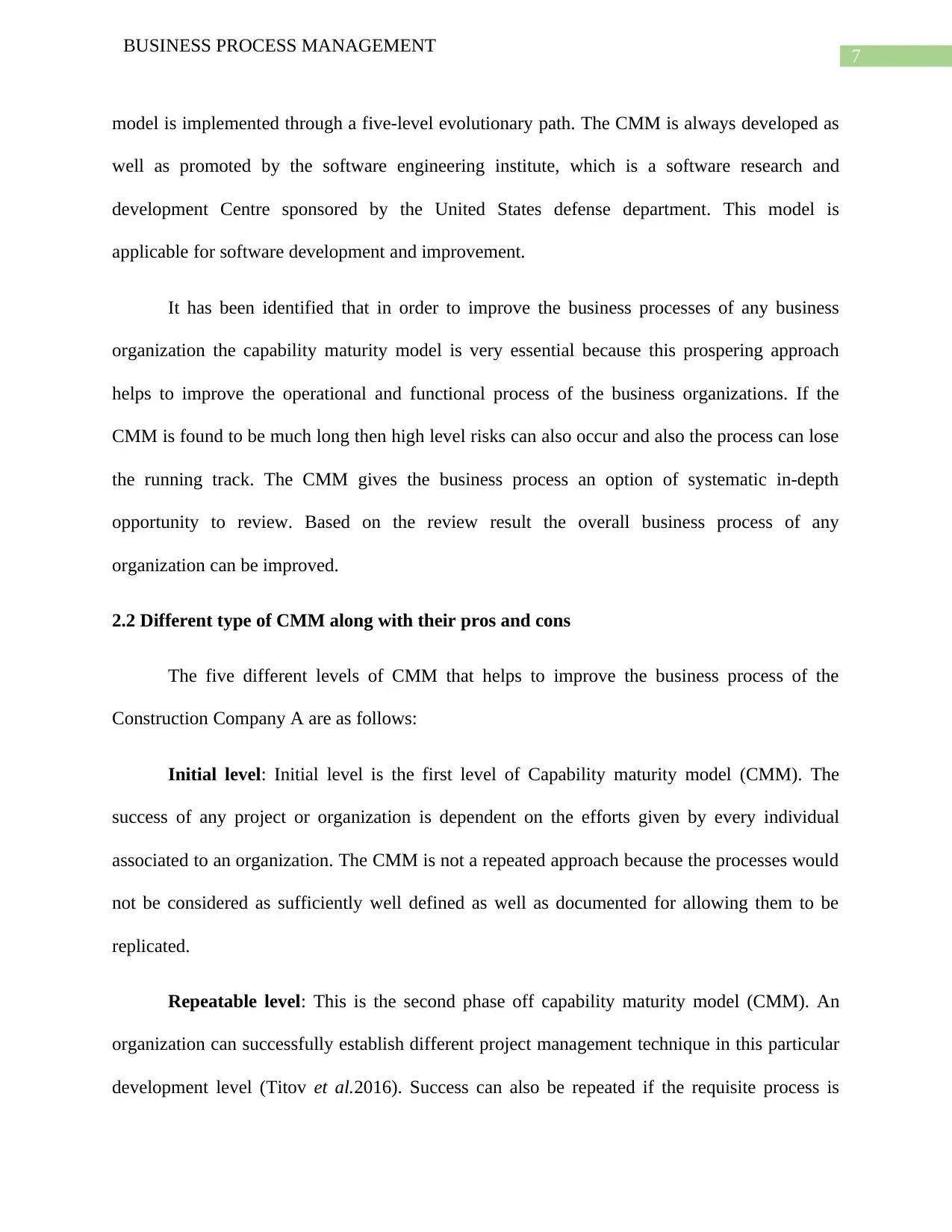
7
BUSINESS PROCESS MANAGEMENT
model is implemented through a five-level evolutionary path. The CMM is always developed as
well as promoted by the software engineering institute, which is a software research and
development Centre sponsored by the United States defense department. This model is
applicable for software development and improvement.
It has been identified that in order to improve the business processes of any business
organization the capability maturity model is very essential because this prospering approach
helps to improve the operational and functional process of the business organizations. If the
CMM is found to be much long then high level risks can also occur and also the process can lose
the running track. The CMM gives the business process an option of systematic in-depth
opportunity to review. Based on the review result the overall business process of any
organization can be improved.
2.2 Different type of CMM along with their pros and cons
The five different levels of CMM that helps to improve the business process of the
Construction Company A are as follows:
Initial level: Initial level is the first level of Capability maturity model (CMM). The
success of any project or organization is dependent on the efforts given by every individual
associated to an organization. The CMM is not a repeated approach because the processes would
not be considered as sufficiently well defined as well as documented for allowing them to be
replicated.
Repeatable level: This is the second phase off capability maturity model (CMM). An
organization can successfully establish different project management technique in this particular
development level (Titov et al.2016). Success can also be repeated if the requisite process is
BUSINESS PROCESS MANAGEMENT
model is implemented through a five-level evolutionary path. The CMM is always developed as
well as promoted by the software engineering institute, which is a software research and
development Centre sponsored by the United States defense department. This model is
applicable for software development and improvement.
It has been identified that in order to improve the business processes of any business
organization the capability maturity model is very essential because this prospering approach
helps to improve the operational and functional process of the business organizations. If the
CMM is found to be much long then high level risks can also occur and also the process can lose
the running track. The CMM gives the business process an option of systematic in-depth
opportunity to review. Based on the review result the overall business process of any
organization can be improved.
2.2 Different type of CMM along with their pros and cons
The five different levels of CMM that helps to improve the business process of the
Construction Company A are as follows:
Initial level: Initial level is the first level of Capability maturity model (CMM). The
success of any project or organization is dependent on the efforts given by every individual
associated to an organization. The CMM is not a repeated approach because the processes would
not be considered as sufficiently well defined as well as documented for allowing them to be
replicated.
Repeatable level: This is the second phase off capability maturity model (CMM). An
organization can successfully establish different project management technique in this particular
development level (Titov et al.2016). Success can also be repeated if the requisite process is
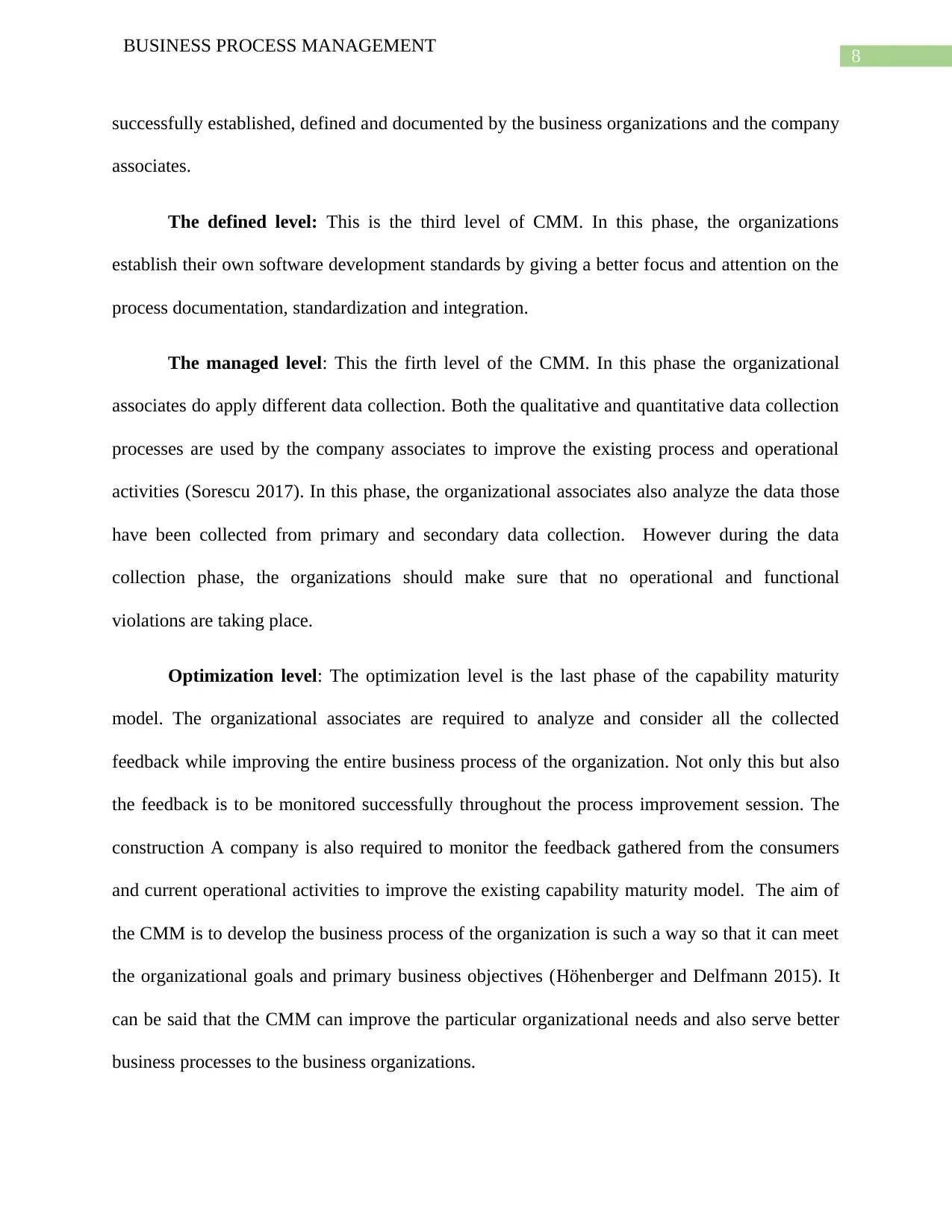
8
BUSINESS PROCESS MANAGEMENT
successfully established, defined and documented by the business organizations and the company
associates.
The defined level: This is the third level of CMM. In this phase, the organizations
establish their own software development standards by giving a better focus and attention on the
process documentation, standardization and integration.
The managed level: This the firth level of the CMM. In this phase the organizational
associates do apply different data collection. Both the qualitative and quantitative data collection
processes are used by the company associates to improve the existing process and operational
activities (Sorescu 2017). In this phase, the organizational associates also analyze the data those
have been collected from primary and secondary data collection. However during the data
collection phase, the organizations should make sure that no operational and functional
violations are taking place.
Optimization level: The optimization level is the last phase of the capability maturity
model. The organizational associates are required to analyze and consider all the collected
feedback while improving the entire business process of the organization. Not only this but also
the feedback is to be monitored successfully throughout the process improvement session. The
construction A company is also required to monitor the feedback gathered from the consumers
and current operational activities to improve the existing capability maturity model. The aim of
the CMM is to develop the business process of the organization is such a way so that it can meet
the organizational goals and primary business objectives (Höhenberger and Delfmann 2015). It
can be said that the CMM can improve the particular organizational needs and also serve better
business processes to the business organizations.
BUSINESS PROCESS MANAGEMENT
successfully established, defined and documented by the business organizations and the company
associates.
The defined level: This is the third level of CMM. In this phase, the organizations
establish their own software development standards by giving a better focus and attention on the
process documentation, standardization and integration.
The managed level: This the firth level of the CMM. In this phase the organizational
associates do apply different data collection. Both the qualitative and quantitative data collection
processes are used by the company associates to improve the existing process and operational
activities (Sorescu 2017). In this phase, the organizational associates also analyze the data those
have been collected from primary and secondary data collection. However during the data
collection phase, the organizations should make sure that no operational and functional
violations are taking place.
Optimization level: The optimization level is the last phase of the capability maturity
model. The organizational associates are required to analyze and consider all the collected
feedback while improving the entire business process of the organization. Not only this but also
the feedback is to be monitored successfully throughout the process improvement session. The
construction A company is also required to monitor the feedback gathered from the consumers
and current operational activities to improve the existing capability maturity model. The aim of
the CMM is to develop the business process of the organization is such a way so that it can meet
the organizational goals and primary business objectives (Höhenberger and Delfmann 2015). It
can be said that the CMM can improve the particular organizational needs and also serve better
business processes to the business organizations.
⊘ This is a preview!⊘
Do you want full access?
Subscribe today to unlock all pages.

Trusted by 1+ million students worldwide

9
BUSINESS PROCESS MANAGEMENT
BUSINESS PROCESS MANAGEMENT
Paraphrase This Document
Need a fresh take? Get an instant paraphrase of this document with our AI Paraphraser
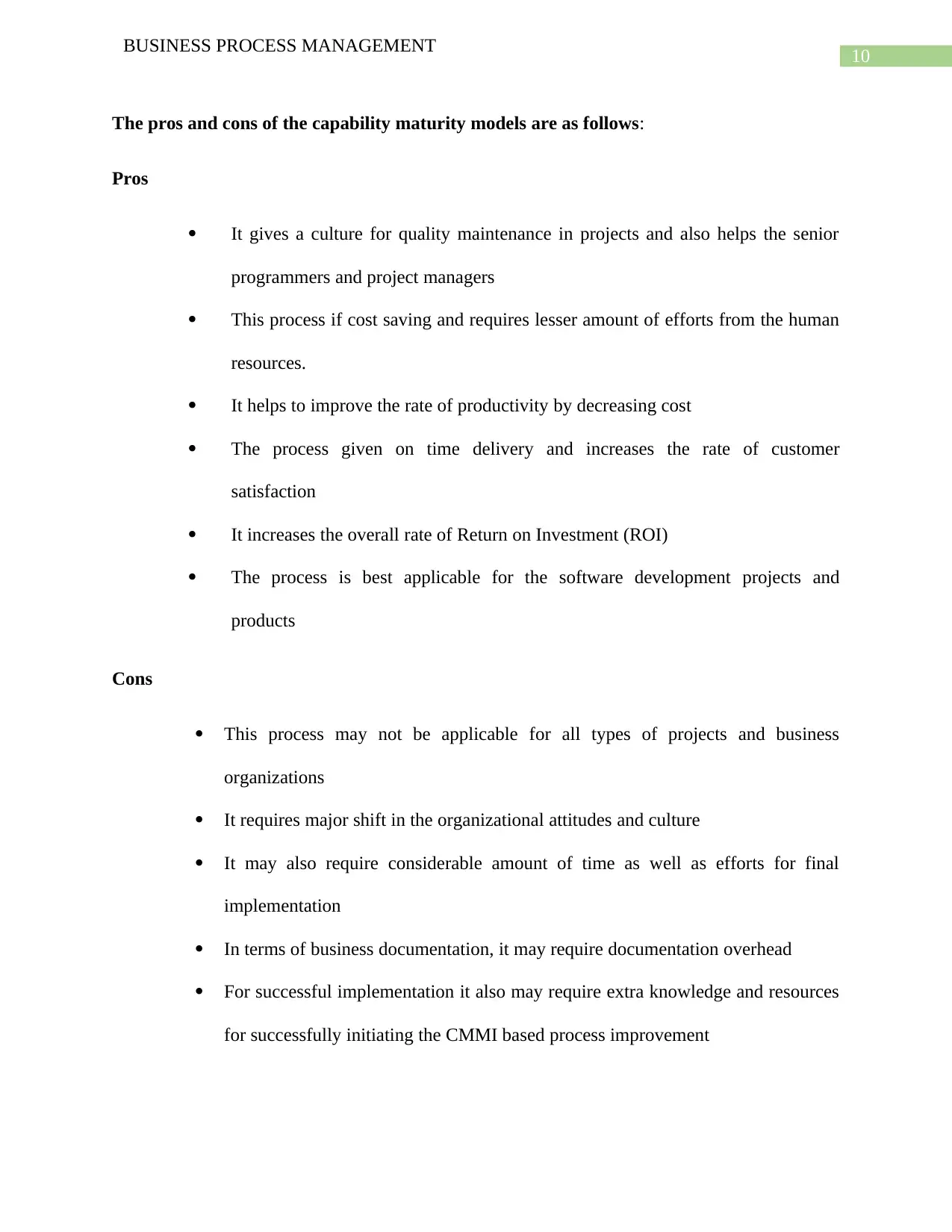
10
BUSINESS PROCESS MANAGEMENT
The pros and cons of the capability maturity models are as follows:
Pros
It gives a culture for quality maintenance in projects and also helps the senior
programmers and project managers
This process if cost saving and requires lesser amount of efforts from the human
resources.
It helps to improve the rate of productivity by decreasing cost
The process given on time delivery and increases the rate of customer
satisfaction
It increases the overall rate of Return on Investment (ROI)
The process is best applicable for the software development projects and
products
Cons
This process may not be applicable for all types of projects and business
organizations
It requires major shift in the organizational attitudes and culture
It may also require considerable amount of time as well as efforts for final
implementation
In terms of business documentation, it may require documentation overhead
For successful implementation it also may require extra knowledge and resources
for successfully initiating the CMMI based process improvement
BUSINESS PROCESS MANAGEMENT
The pros and cons of the capability maturity models are as follows:
Pros
It gives a culture for quality maintenance in projects and also helps the senior
programmers and project managers
This process if cost saving and requires lesser amount of efforts from the human
resources.
It helps to improve the rate of productivity by decreasing cost
The process given on time delivery and increases the rate of customer
satisfaction
It increases the overall rate of Return on Investment (ROI)
The process is best applicable for the software development projects and
products
Cons
This process may not be applicable for all types of projects and business
organizations
It requires major shift in the organizational attitudes and culture
It may also require considerable amount of time as well as efforts for final
implementation
In terms of business documentation, it may require documentation overhead
For successful implementation it also may require extra knowledge and resources
for successfully initiating the CMMI based process improvement
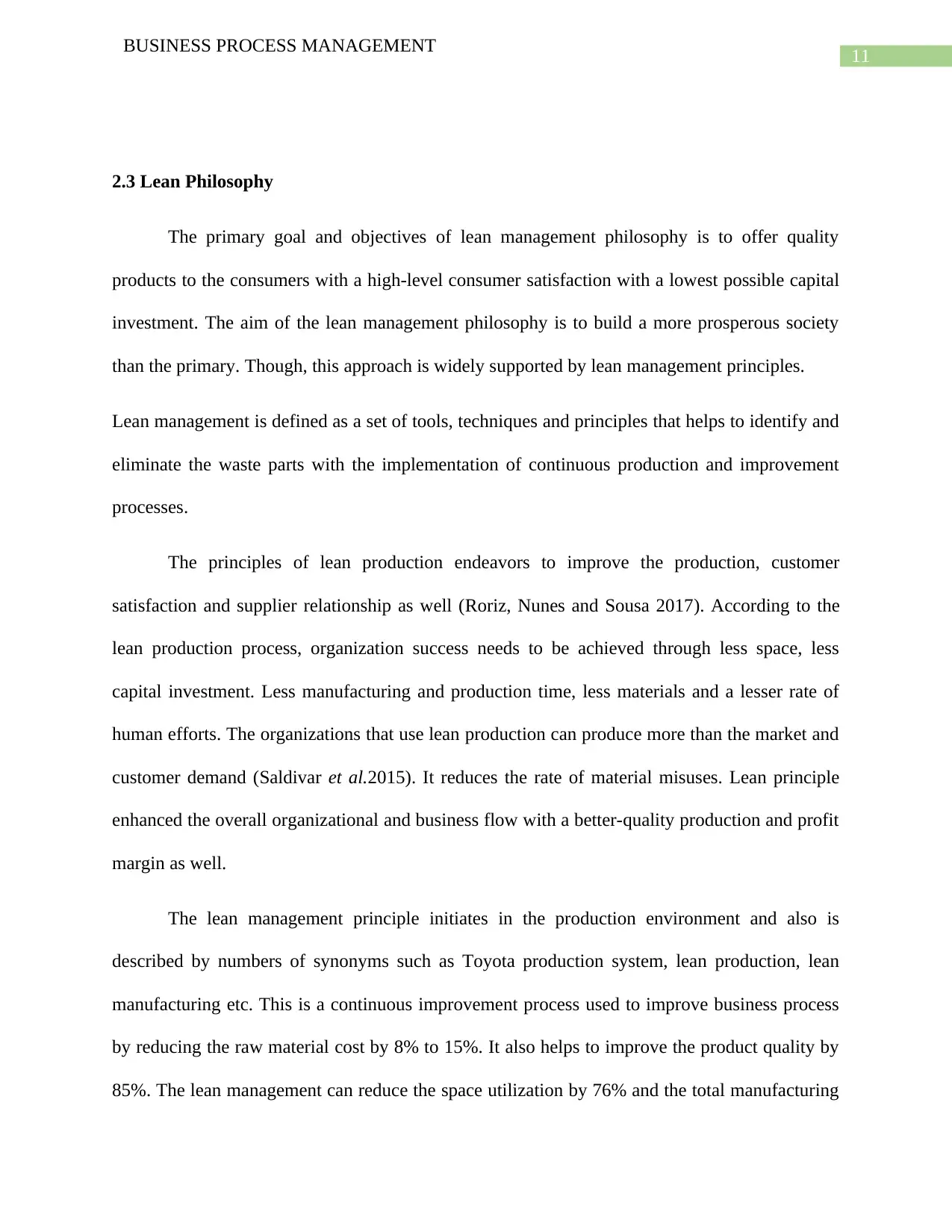
11
BUSINESS PROCESS MANAGEMENT
2.3 Lean Philosophy
The primary goal and objectives of lean management philosophy is to offer quality
products to the consumers with a high-level consumer satisfaction with a lowest possible capital
investment. The aim of the lean management philosophy is to build a more prosperous society
than the primary. Though, this approach is widely supported by lean management principles.
Lean management is defined as a set of tools, techniques and principles that helps to identify and
eliminate the waste parts with the implementation of continuous production and improvement
processes.
The principles of lean production endeavors to improve the production, customer
satisfaction and supplier relationship as well (Roriz, Nunes and Sousa 2017). According to the
lean production process, organization success needs to be achieved through less space, less
capital investment. Less manufacturing and production time, less materials and a lesser rate of
human efforts. The organizations that use lean production can produce more than the market and
customer demand (Saldivar et al.2015). It reduces the rate of material misuses. Lean principle
enhanced the overall organizational and business flow with a better-quality production and profit
margin as well.
The lean management principle initiates in the production environment and also is
described by numbers of synonyms such as Toyota production system, lean production, lean
manufacturing etc. This is a continuous improvement process used to improve business process
by reducing the raw material cost by 8% to 15%. It also helps to improve the product quality by
85%. The lean management can reduce the space utilization by 76% and the total manufacturing
BUSINESS PROCESS MANAGEMENT
2.3 Lean Philosophy
The primary goal and objectives of lean management philosophy is to offer quality
products to the consumers with a high-level consumer satisfaction with a lowest possible capital
investment. The aim of the lean management philosophy is to build a more prosperous society
than the primary. Though, this approach is widely supported by lean management principles.
Lean management is defined as a set of tools, techniques and principles that helps to identify and
eliminate the waste parts with the implementation of continuous production and improvement
processes.
The principles of lean production endeavors to improve the production, customer
satisfaction and supplier relationship as well (Roriz, Nunes and Sousa 2017). According to the
lean production process, organization success needs to be achieved through less space, less
capital investment. Less manufacturing and production time, less materials and a lesser rate of
human efforts. The organizations that use lean production can produce more than the market and
customer demand (Saldivar et al.2015). It reduces the rate of material misuses. Lean principle
enhanced the overall organizational and business flow with a better-quality production and profit
margin as well.
The lean management principle initiates in the production environment and also is
described by numbers of synonyms such as Toyota production system, lean production, lean
manufacturing etc. This is a continuous improvement process used to improve business process
by reducing the raw material cost by 8% to 15%. It also helps to improve the product quality by
85%. The lean management can reduce the space utilization by 76% and the total manufacturing
⊘ This is a preview!⊘
Do you want full access?
Subscribe today to unlock all pages.

Trusted by 1+ million students worldwide
1 out of 28
Related Documents
Your All-in-One AI-Powered Toolkit for Academic Success.
+13062052269
info@desklib.com
Available 24*7 on WhatsApp / Email
![[object Object]](/_next/static/media/star-bottom.7253800d.svg)
Unlock your academic potential
Copyright © 2020–2025 A2Z Services. All Rights Reserved. Developed and managed by ZUCOL.




